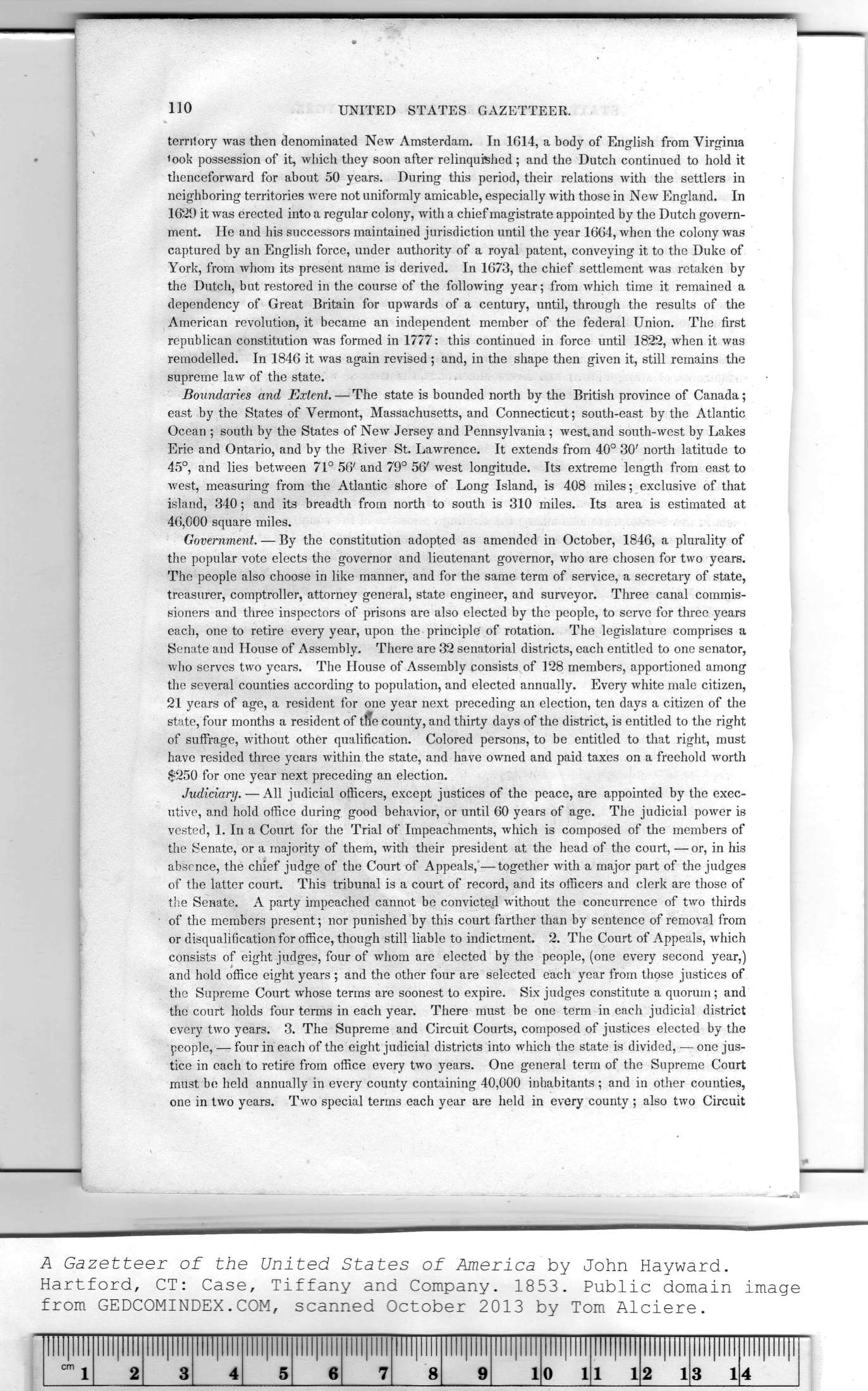|
|
Note: Ctrl and + increases the font size of the text below, Ctrl and - decreases it, and Ctrl and 0 resets it to default size.
110 UNITED STATES GAZETTEER.
territory was then denominated New Amsterdam. In 1614, a body of English from Virginia
look possession of it, which they soon after relinquished ; and the Dutch continued to hold it
thenceforward for about 50 years. During this period, their relations with the settlers in
neighboring territories were not uniformly amicable, especially with those in New England. In
1629 it was erected into a regular colony, with a chief magistrate appointed by the Dutch govern-
ment. He and his successors maintained jurisdiction until the year 1664, when the colony was
captured by an English force, under authority of a royal patent, conveying it to the Duke of
York, from whom its present name is derived. In 1673, the chief settlement was retaken by
the Dutch, but restored in the course of the following year; from which time it remained a
dependency of Great Britain for upwards of a century, until, through the results of the
American revolution, it became an independent member of the federal Union. The first
republican constitution was formed in 1777: this continued in force until 1822, when it was
remodelled. In 1846 it was again revised ; and, in the shape then given it, still remains the
supreme law of the state.
Boundaries and Extent. — The state is bounded north by the British province of Canada;
east by the States of Vermont, Massachusetts, and Connecticut; south-east by the Atlantic
Ocean ; south by the States of New Jersey and Pennsylvania ; west and south-west by Lakes
Erie and Ontario, and by the River St. Lawrence. It extends from 40° 30' north latitude to
45°, and lies between 71° 56' and 79° 56' west longitude. Its extreme length from east to
Avest, measuring from the Atlantic shore of Long Island, is 408 miles; exclusive of that
island, 340; and its breadth from north to south is 310 miles. Its area is estimated at
46,000 square miles.
Government. — By the constitution adopted as amended in October, 1846, a plurality of
the popular vote elects the governor and lieutenant governor, Avho are chosen for two years.
The people also choose in like manner, and for the same term of service, a secretary of state,
treasurer, comptroller, attorney general, state engineer, and surveyor. Three canal commis-
sioners and three inspectors of prisons are also elected by the people, to serve for three years
each, one to retire every year, upon the principle of rotation. The legislature comprises a
Senate and House of Assembly. There are 32 senatorial districts, each entitled to one senator,
who serves two years. The House of Assembly consists of 128 members, apportioned among
the several counties according to population, and elected annually. Every white male citizen,
21 years of age, a resident for one year next preceding an election, ten days a citizen of the
state, four months a resident of tfie county, and thirty days of the district, is entitled to the right
of suffrage, Avithout other qualification. Colored persons, to be entitled to that right, must
have resided three years Avithin the state, and have owned and paid taxes on a freehold worth
$250 for one year next preceding an election.
Judiciary. — All judicial officers, except justices of the peace, are appointed by the exec-
utive, and hold office during good behavior, or until 60 years of age. The judicial power is
vested, 1. In a Court for the Trial of Impeachments, which is composed of the members of
the Senate, or a majority of them, Avith their president at the head of the court, — or, in his
absence, the chief judge of the Court of Appeals,—together with a major part of the judges
of the latter court. This tribunal is a court of record, and its officers and clerk are those of
the Senate. A party impeached cannot be convicted Avithout the concurrence of two thirds
of the members present; nor punished by this court farther than by sentence of removal from
or disqualification for office, though still liable to indictment. 2. The Court of Appeals, Avhich
consists of eight judges, four of Avhom are elected by the people, (one every second year,)
and hold office eight years ; and the other four are selected each year from those justices of
the Supreme Court Avhose terms are soonest to expire. Six judges constitute a quorum; and
the court holds four terms in each year. There must be one term in each judicial district
every tAvo years. 3. The Supreme and Circuit Courts, composed of justices elected by the
people, — four in each of the eight judicial districts into which the state is divided, — one jus-
tice in each to retire from office every two years. One general term of the Supreme Court
must bn held annually in every county containing 40,000 inhabitants ; and in other counties,
one in two years. Two special terms each year are held in every county ; also two Circuit
A Gazetteer of the United States of America by John Hayward.
Hartford, CT: Case, Tiffany and Company. 1853. Public domain image
|
